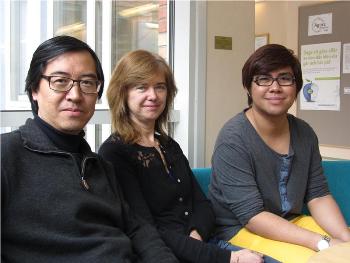May 2 2013
Professor Weimin Chen and his colleagues at Linköping University, in cooperation with German and American researchers, have succeeded in both initializing and reading nuclear spins, relevant to qubits for quantum computers, at room temperature. The results have just been published in the renowned journal Nature Communications.
 Professors Weimin Chen, Irina Buyanova and PhD student Yuttapoom Puttisong
Professors Weimin Chen, Irina Buyanova and PhD student Yuttapoom Puttisong
A quantum computer is controlled by the laws of quantum physics; it promises to perform complicated calculations, or search large amounts of data, at a speed that exceeds by far those that today’s fastest supercomputers are capable of.
“You could say that a quantum computer can think several thoughts simultaneously, while a traditional computer thinks one thought at a time,” says Weimin Chen, professor in the Division of Functional Electronic Materials at the Department of Physics, Chemistry and Biology at LiU, and one of the main authors of the article in Nature Communications.
A traditional computer stores, processes and sends all information in the form of bits, which can have a value of 1 or 0. But in the world of quantum physics, at the nano- and atomic level, other rules prevail and a bit in a quantum computer – a qubit – can have any value between 1 and 0. A spin-based qubit makes use of the fact that electrons and atomic nuclei rotate around their own axes – they have a spin. They can rotate both clockwise and counterclockwise (equivalent to 1 and 0), and in both directions simultaneously (a mix of 1 and 0) – something that is completely unthinkable in the traditional, “classical” world.
An atomic nucleus consists of both protons and neutrons, and the advantage of using the nuclear spin as a qubit is that the nucleus is well protected, and nearly impervious to unwanted electromagnetic disturbance, which is a condition for keeping the sensitive information in the qubit intact.
The first step in building a quantum computer is to assign each qubit a well-defined value, either 1 or 0. Starting, or initiating, the spin-based qubits then requires all the atomic nuclei to spin in the same direction, either ‘up’ or ‘down’ (clockwise or counterclockwise). The most common method for polarising nuclear spin is called dynamic nuclear polarisation; this means that the electrons’ spin simply influences the nucleus to spin in the same direction. The method requires strongly spin polarised electrons and functions superbly at lower temperatures. Dynamic nuclear polarisation via conduction electrons has, however, not yet been demonstrated at room temperature – which is crucial for the method to be useful in practice for the development of quantum computers. The main problem is that the spin orientation in the electrons can easily be lost at room temperature, since it is sensitive to disruptions from its surroundings.
Linköping University researchers Yuttapoom Puttisong, Xingjun Wang, Irina Buyanova and Weimin Chen, together with their German and American colleagues, have now discovered a way of getting around this problem.
Back in 2009, Chen and his research group presented a spin filter that works at room temperature; the filter lets through electrons that have the desired spin direction and screens out the others.
With the help of the spin filter, they have now succeeded in producing a flow of free electrons with a given spin in a material – in this case GaNAs (gallium nitrogen arsenide). The spin polarisation is so strong that it creates a strong polarisation of the nuclear spin in extra Ga atoms that are added as defects in the material – and this takes place at room temperature. This is the first time that strong nuclear spin polarisation of a defect atom in a solid is demonstrated at room temperature by spin-polarised conduction electrons.
“We prove experimentally that the measurable magnetic field from the nuclei, as well as the strong polarisation of the nuclear spins in the material at room temperature, comes from the dynamic polarisation of the nuclear spin in the extra added Ga atoms,” says Chen.
The researchers have also shown that the polarisation of the nuclear spin happens very quickly – potentially in less than a nanosecond (one-billionth of a second).
The method proposed also has the advantage of making use of free electrons. This makes it possible to control the polarisation of the spin in the nucleus electrically; in this way the information lying in the spin can both be initiated and read.